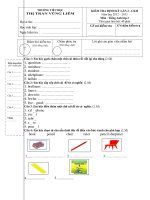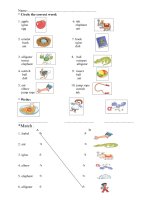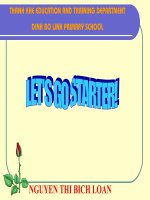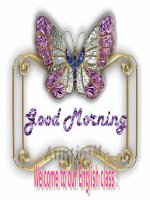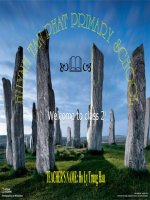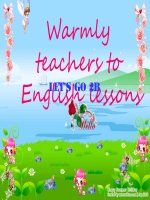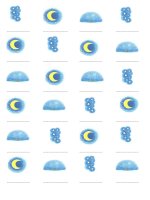Tiếng Anh lớp 2 G2 selective lessonplan unit2
Bạn đang xem bản rút gọn của tài liệu. Xem và tải ngay bản đầy đủ của tài liệu tại đây (455.33 KB, 21 trang )
Family and Friends Special Edition Grade 2– Unit 2: Playtime!
Lesson One Words
Objectives
To identify common toys
To understand a short story
Language
Language focus: speaking, reading
Vocabulary: doll, ball, teddy bear, car
Resources and materials
Student Book p. 14
Workbook p. 14
Audio Tracks 15, 21–23
Realia: A pencil case, a school bag (students’ items can be used)
Flashcards 29–32
Story poster 2
One set of student picture cards per group, cut up
Worksheet 1: Tidy up! (one copy per student)
A reader of your choice
Introduction
Weather report: Ask the class about today's weather.
Song: Play a warm-up song.
Warmer
To energize the class and review vocabulary from the last unit, ask children to turn to page 10 in their Student Books
and sing Open the book! (Track 15)
Lead-in
Use Flashcards 29–32 to elicit the vocabulary for this lesson. Hold them up one at a time and ask What’s this? Model
any words that children don’t know.
Give Flashcards 29–32 to four different children. Ask them to stand up, one at a time. They show their card for the
class to shout out the word.
Presentation
Listen, point, and repeat. (Exercise 1)
Ask children to open their Student Books and look at the pictures of the different possessions.
Play the first part of the recording (Track 21, Listen and point) for children to listen and point to the appropriate
picture. Repeat if necessary.
Play the second part of the recording (Track 21, Listen and repeat) for children to repeat.
Play the recording all the way through for children to listen and point and then repeat the words in chorus.
Transcript (Track 21)
Listen and point.
doll, ball, teddy bear, car
ball, teddy bear, doll, car
Listen and repeat.
doll, ball, teddy bear, car
Listen, point, and say
Place Flashcards 29–32 around the classroom.
Call out a vocabulary word, e.g., ball. The children point to the correct flashcard.
Now point to the flashcard. The children say the word.
© Oxford University Press 2015
1
Family and Friends Special Edition Grade 2– Unit 2: Playtime!
Option: Describe the location of the card, e.g., It’s next to the door. What is it? The children then say the word.
What do I have?
Hold up one card so that the class can only see the back of it.
Ask What’s this? for children to make guesses.
When the card has been guessed correctly, put it on the board.
Hold up a second card and repeat the procedure.
Continue until all the cards are on the board.
Variation: To make the game more exciting, limit children to three guesses. If they name the card within three
guesses, the class wins the card. If they don’t, the teacher wins the card. Put the cards the class has won and the
cards the teacher has won on opposite sides of the board. At the end of the game add up the scores with the class.
Listen and chant. (Exercise 2)
Play the recording (Track 22) for children to listen to the chant.
Place Flashcards 29–32 on the board. Play the chant a second time for children to point to say and the words. This
time they can point to the correct flashcard when they hear it. Repeat (more than once if necessary).
Transcript (Track 22)
doll, ball, teddy bear, car
Listen and read. (Exercise 3)
Use Story poster 2 to present the story. Point to Rosy and ask Who’s this? Do the same for Tim. Ask children to name
as many things in the picture as they can.
Hold up a pencil case so that the class can see it. Ask What’s this? Do the same with a student’s bag. Ask the students
to point to the pencil case and the bag in the picture.
Talk about each frame with the class. Ask What’s happening? Encourage predictions from different members of the
class.
Ask children to look at the poster while you play the recording (Track 23) for them to listen. Point to each speech
bubble as you hear the text.
Play the recording again as children listen and point to the pictures.
Ask comprehension questions, e.g., What is lost? Where’s the teddy bear? Who finds the teddy bear?
Ask children to open their Student Books. Tell them to listen and follow the words in the story as you play the
recording again.
Ask children to find and point to the words from Exercises 1 and 2 that appear in the story.
Make me move!
Give Flashcards 29–32 to four different children. Play the recording again. Each time the children hear their object
mentioned, they hold the flashcard in the air.
Repeat with four more children.
Development
Slap
Put children into small groups. Give each group a set of the student picture cards and place them face up on the desk.
Call out a word, e.g., doll. The first child in each group who slaps the correct card and says the word takes it.
Repeat with a different word.
Continue calling out the words in a random order until you have said each of the four words three times.
The child in each pair holding the most cards is the winner.
If a number of groups have a tie, play again.
Quick word
Divide the class into small groups. Give each group a set of student picture cards. Each group shuffles their cards and
places them in a pile face down on the desk.
Children take turns to turn over cards one at a time.
As each card is shown, children say what it is, e.g., teddy bear.
The child who says the word first wins the card.
The winner is the child with the most cards at the end.
© Oxford University Press 2015
2
Family and Friends Special Edition Grade 2– Unit 2: Playtime!
Consolidation
Worksheet 1: Tidy up!
Give each child a copy of Worksheet 1. Explain to children that Rosy’s toys are all over the floor in her room and that
the children need to tidy it by putting the toys in Rosy’s toy box. They do this by drawing lines from the toys to the
words in the toy box.
Point to the picture of the teddy bear. Ask What’s this? (teddy bear)
Ask children to find the word teddy bear in Rosy’s bag. Say Draw a line and demonstrate. Prompt children to draw the
line.
Children complete the worksheet independently and then check with their peers.
Exercises: Workbook page 14
Story time: A reader of your choice
© Oxford University Press 2015
3
Family and Friends Special Edition Grade 2– Unit 2: Playtime!
Lesson Two Grammar
Objectives
To ask and answer questions with my and your
To write answers to the question Is this your...?
To act out a story
Language
Language focus: listening, speaking, writing
Vocabulary: common toys, my, your
Is this your...?
Yes, it is.
No, it isn’t.
Resources and materials
Student Book p. 15
Workbook p. 15
Audio Tracks 23–24
Flashcards 29–32
Story poster 2
Introduction
Weather report: Ask the class about today's weather.
Song: Play a warm-up song.
Warmer
Play Snap! with the class using Flashcards 29–32 to review the toys words from the previous lesson.
Write one of the items from the vocabulary set on the board, e.g., doll. Say the word aloud.
Put the flashcards in a pile and hold them up so that the children can only see the facing card. Reveal the cards one at
a time by putting the front card to the back. When children see the doll, they shout Snap!
Repeat with the rest of the words in the set.
Lead-in
Point to Story poster 2 and ask children what happened in the story.
Cover up the poster and ask children which toys and possessions appeared in the story. Write their answers on the
board (a doll, a ball, a pencil case, a bag, a teddy bear, and a car).
Presentation
Listen to the story and repeat. Act. (Exercise 1)
Ask children to turn to the story on page 14 of their Student Books. Check how many objects they remembered in the
lead-in activity and write a next to them on the board.
Play the recording (Track 23) once through. Play again, pausing for children to repeat.
Divide the class into pairs. One child is Rosy and the other is Tim.
Ask children to look at the pictures and decide together on the actions for the story (see suggestions below).
Children practice acting out the story. Monitor the activity, checking for correct pronunciation.
Ask some of the pairs to come to the front of the class to act out the story.
Story actions
Picture 1: Tim picks up two objects to give to Rosy.
Picture 2: Tim passes Rosy a pencil case. She unzips it.
Picture 3: Tim picks up Rosy’s bag. Rosy looks round.
Picture 4: Rosy opens the bag.
Listen and say. (Exercise 2)
Look at the pictures and say what’s happening in each one. Copy the sentences and questions from the Student Book
© Oxford University Press 2015
4
Family and Friends Special Edition Grade 2– Unit 2: Playtime!
onto the board, leaving spaces where the toy words are.
Put different flashcards in the spaces to elicit sentences and questions with the same pattern, e.g., This is my doll, Is
this your bag?
Ask individual children to come to the front and substitute a flashcard to make a new sentence.
Play the recording (Track 24) all the way through. Then play the recording again, pausing for children to repeat each
line.
Point to yourself and ask children which word we use to show something belongs to me (my). Point to somebody else
and ask which word we use to show that it belongs to the person we are talking to (your).
Read and find.
Ask children to reread the story on page 14 and find the sentences and questions from the Let’s learn! box.
Development
Look and say. (Exercise 3)
Model the dialogue with a child. Put children in pairs. Ask one of the pairs to read the example for the class.
Describe another picture for the children to say the number.
Ask children to work with their partners, taking turns describing the pictures for their partners to guess the number.
Monitor and help where necessary.
Ask different children to describe pictures for the class to say the number.
Answers
1. This is your ball.
2. This is my bag.
3. This is your car.
Charades
Mime handing a ball to someone to elicit This is your ball.
Ask a child to come to the front of the class. He/She mimes another picture from Exercise 3. If necessary, help the
child by showing him/her one of the pictures.
The other children guess the sentence. The first child to guess correctly comes to the front of the class and mimes
another picture.
Continue to play in this way. Once the three pictures have been used, children think of their own sentences to mime.
Write. (Exercise 4)
Ask children to look again at the story on page 14 of their Student Books. Point out the questions in pictures 2 and 3.
Read them aloud for children to repeat.
Ask children to look at the pictures on page 15 of their books. Ask a child to read the example answer to the class.
Children work individually and write answers to the questions, using the phrases in the word box as models.
Go through the exercise with the class. Ask the questions for the class to say the answers in chorus.
Answers
1. No, it isn’t.
2. Yes, it is.
3. No, it isn’t.
4. yes, it is.
Consolidation
Let’s Practice!
Ask students to look at the picture and speech bubble.
Have a student demonstrate the sentence for the class.
Have students work in pairs to take turns saying the sentence. Tell them to use other vocabulary words on the page.
Shout Yes or No!
Call one child to the front and give him/her the doll and ball flashcards to hold up. Hold the teddy bear and car
flashcards yourself.
Say This is my teddy bear. The class calls out Yes! Then indicate the child standing next to you and say This is your
© Oxford University Press 2015
5
Family and Friends Special Edition Grade 2– Unit 2: Playtime!
teddy bear. The class calls out No!
Repeat with This is my doll. The class calls out No! Then say This is your doll, indicating the child next to you, for the
class to calls out Yes!
Repeat the activity with other children.
Detectives
Choose two students to be detectives and ask them to leave the room.
Give four students in the class the four toy flashcards. Tell them This is your doll, etc.
Collect the flashcards. Call in the two “detectives” and give them all four flashcards.
Detectives walk around the class asking Is this your doll? etc., until they find the “owners” of the four toys.
Repeat with different students.
Exercises: Workbook page 15
Story time: A reader of your choice
© Oxford University Press 2015
6
Family and Friends Special Edition Grade 2– Unit 2: Playtime!
Lesson Three Song
Objectives
To identify more words for toys and use words in the context of a song
To help children develop their listening and singing skills
Language
Language focus: listening, speaking
Vocabulary: kite, bike, train, recycled toy words
Extra vocabulary: big, love (v), toy
Resources and materials
Student Book p. 16
Workbook p. 16
Audio Track 22, 25–26
Flashcards 33–35
One set of picture cards per small group
One counter per child (e.g., a plastic chip)
One piece of paper per pair
Coloring pens or pencils
Culture note: Toys
People in the US spent about $22 billion a year on toys in 2010. Computer games and video games are very popular
toys. Dolls, action figures, and cars are also favorites. Toys that are related to movies and TV shows are very popular,
especially with young children. Many children still play with traditional toys, like board games and puzzles. “The
teddy bear craze” started in the United States in the early 1900s, and teddy bears are still popular today.
Introduction
Weather report: Ask the class about today's weather.
Song: Play a warm-up song.
Warmer
Ask children to turn to page 14. Play the recording (Track 22) and say the chant together to review all the toy words
they have learned so far.
Lead-in
Use Flashcards 33–35 to introduce the three new words. Hold them up one at a time and say the words for children
to repeat.
Put the flashcards in different places around the room. Say the words for children to point to the correct flashcard
and repeat.
Presentation
Listen, point, and repeat. (Exercise 1)
Ask children to look at the pictures. Play the first part of the recording (Track 25, Listen and point) for children to point
to the words.
Play the second part of the recording (Track 25, Listen and repeat) for children to repeat the words.
Play the recording all the way through for children to listen and point and then repeat.
Ask individual children to say the words for the class.
Hold up Flashcards 33–35 one at a time and ask individual children What’s this?
Transcript (Track 25)
Listen and point.
kite, bike, train
© Oxford University Press 2015
7
Family and Friends Special Edition Grade 2– Unit 2: Playtime!
bike, train, kite
Listen and repeat.
kite, bike, train
Charades
Mime riding a bike to elicit bike.
Ask a child to come to the front of the class. He/She mimes an activity using a toy from this lesson or Lesson One. If
necessary, help the child by showing him/her one of the flashcards.
The other children guess the word. The first child to guess correctly comes to the front of the class and mimes
another activity.
Continue to play in this way until all of the vocabulary has been used.
Listen and sing. (Exercise 2)
Ask children to look at the pictures for the song and see whether they can guess what the song is about (toys). Point
to the toys on the page one at a time and ask different children What’s this?
Play the recording (Track 26) for children to listen and point to the pictures when they hear the three new words.
Listen again and ask them to follow the words in their books.
Recite the words of the song with the class, without the music. Say each line and ask children to repeat.
Play the recording again for children to sing along.
Sing and do. (Exercise 3)
Ask children to look at the pictures and decide together on what the actions should be (see suggestions below).
Practice the actions with the class.
Play the recording for children to sing the song and do the actions.
Song actions
kite – arms in the air, holding a string
bike – move hands in a pedaling motion
train – use an arm to show a train moving along a track
Development
That’s my word!
Assign each child a toy word from the song, so that there are several kites, bikes, and trains in the class.
Play the song. Each time children hear their word, they jump up.
Change the children’s words. Say Now bikes are trains, trains are kites, and kites are bikes. Play the song again for
children to jump up when they hear their new word.
This is my toy!
Put children into small groups. Give each child a counter and each group a set of Student Picture cards.
Children spread out the Student Picture cards, face down, in front of them.
Children take turns to try and throw the counter so it lands on one of the cards. If they are successful, they turn over
the card and make a sentence, e.g., This is my kite. They then pick up the card and keep it.
The winner is the child with the most cards at the end.
(Student Picture cards: Cuttable worksheet with 15 squares with 15 pictures, kite (x5), bike (x5), train (x5))
Consolidation
Write your own verse.
Children work in pairs to create an original verse for the song by inserting different toy words. Write different words
for toys and colors on the board for children to choose from. Encourage children to illustrate their verse, and then
display it in the classroom.
Children sing the song again with the new verses.
Exercises: Workbook page 16
Story time: A reader of your choice
© Oxford University Press 2015
8
Family and Friends Special Edition Grade 2– Unit 2: Playtime!
Lesson Four Phonics
Objectives
To recognize the uppercase and lowercase forms of the letter e, f, g, and h, and associate them with their
corresponding sounds
To pronounce the sounds /ɛ/, /f/ /g/, and /h/ on their own and at the beginning of words
To learn the names of the letters e, f, g, and h
Language
Language focus: listening, speaking, reading
Vocabulary: egg, fig, goat, hat
Resources and materials
Student Book p. 17
Workbook p. 17
Audio Tracks 17, 27–29
Phonics cards 5–8
Worksheet 2: Chopsticks relay (one copy per group)
One set of Missing letters per group, cut up
One pair of chopsticks per group
Introduction
Weather report: Ask the class about today's weather.
Song: Play a warm-up song.
Warmer
Ask children which letters from the alphabet they have already learned (a, b, c, d). Ask them to name any words they
know that begin with these sounds.
Play the recording and say the chant from page 11 (Track 17) of the Student Book to practice the sounds these letters
make.
Lead-in
Write Ee, Ff, Gg, and Hh on the board. Point to each one, one at a time, and say the letter name and then the sound
for both uppercase and lowercase letters for children to repeat.
Say the sounds again for children to draw the uppercase letters in the air. Say the sounds several times for children to
draw the lowercase letters.
Elicit the words on the phonics cards. Say the letter names, sounds, and then the words for children to repeat.
Write the corresponding words egg, fig, goat, hat next to the letters on the board. Circle the first letter of each word.
Point to the words and say the beginning sound (not the whole word) for children to repeat.
Hold up Phonics cards 5–8, one at a time. Say the words for children to repeat. Hold up the cards in a different order
and repeat.
Presentation
Listen, point, and repeat. (Exercise 1)
Ask children to look at the letters in their Student Books.
Play the first part of the recording (Track 27, Listen and point) for children to listen and point to the letters.
Play the second part of the recording (Track 27, Listen and repeat) for children to repeat the letter names, sounds,
and words in chorus. Play the recording as many times as necessary.
Play the recording all the way through for children to point to the words and then repeat them.
Transcript (Track 27)
Listen and point.
Letter Ee /ɛ/ egg, Letter Ff /f/ fig, Letter Gg /g/ goat, Letter Hh /h/ hat
Letter Hh /h/ hat, Letter Gg /g/ goat, Letter Ff /f/ fig, Letter Ee /ɛ/ egg
Listen and repeat.
© Oxford University Press 2015
9
Family and Friends Special Edition Grade 2– Unit 2: Playtime!
Letter Ee /ɛ/ egg, Letter Ff /f/ fig, Letter Gg /g/ goat, Letter Hh /h/ hat
Development
Listen and chant. (Exercise 2)
Play the recording (Track 28) for children to listen to the chant.
Put Phonics cards 5–8 in different places around the room. Play the recording again for children to point to the cards
as they hear the words.
Play the chant once more, stopping the recording after each line for children to repeat. Repeat, and encourage
children to follow the chant in their book.
Your line, our line
Divide the class into four groups: eggs, figs, goats, and hats.
Do the chant together.
Each group says their own lines.
Listen to the sounds and connect the letters. (Exercise 3)
Elicit the names for the pictures in the activity (goat, fig, and hat). Ask What does the goat have? Tell children they
can find out the answer by listening. Explain that they are going to hear different sounds and words from the lesson.
They have to follow the sounds in the maze and draw a line to connect the letters to find out what the goat has – a fig
or a hat.
Play the beginning of the recording (Track 29) and follow the blue line with your pencil to demonstrate.
Play the recording for children to listen and link the letters.
Play the recording again for children to check their answers. Repeat.
Ask What does the goat have? (a fig). To check the answers, ask children to look at their mazes and say the letters
they heard as you write them on the board.
Transcript (Track 29)
/f/ fig, /ɛ/ egg, /h/ hat, /g/ goat, /g/ goat, /h/ hat, /f/ fig
Answer
The goat has a fig.
Read and circle the sounds e, f, g, h at the start of the words. (Exercise 4)
Ask children to look at the pictures. Ask What does the egg have? (a hat). What does the goat have? (a fig).
Read the text for children to follow in their books. Write the first line on the board.
Show children the circled e at the beginning of egg. Draw a circle around the e on egg on the board.
Ask children to find and circle other examples of e, f, g, and h at the beginning of words in their books. As they are
working, write the rest of the chant on the board.
Go over the answers with the class, asking them to come up and circle letters on the board.
Answers
There’s an egg with a yellow hat.
Look, the goat has a fig.
The goat likes figs.
Consolidation
Let’s Practice!
Ask students to look at the picture and speech bubble. Say I have a hat.
Have a student read the sentence.
Have students work in pairs and take turns saying the sentence. Tell them to use other vocabulary words on the page.
Read My Lips.
Say one of the sounds and words silently, only mouthing the sound and word e.g., Ff, fig. Children try to guess the
sound and word.
The child who guesses correctly first mouths another word.
After doing a few demonstrations as a class, divide the children into small groups to continue.
© Oxford University Press 2015
10
Family and Friends Special Edition Grade 2– Unit 2: Playtime!
Worksheet 2: Chopsticks relay
Divide the class into small groups. Give each group a pair of chopsticks and a copy of Worksheet 2.
Put a set of Missing letters a few meters away from each group.
The first child goes to the set of letters, picks up a letter with the chopsticks, returns to the group, and places the
letter into an appropriate gap on Worksheet 2.
The second child then takes the chopsticks and goes to collect the second letter.
Exercises: Workbook page 17
Story time: A reader of your choice
© Oxford University Press 2015
11
Family and Friends Special Edition Grade 2– Unit 2: Playtime!
Lesson Five Skills Time!
Objectives
Reading: read and understand a poem
Language
Recycled: vocabulary and structures seen previously
Extra: favorite, may, like, it, too
Resources and materials
Student Book p. 18
Workbook p. 18
Audio Track 22 (optional) and 30
Toys flashcards 29–35
Worksheet 3: Illustrate the poem (one copy per child)
Coloring pens or pencils
Introduction
Weather report: Ask the class about today's weather.
Song: Play a warm-up song.
Warmer
Play Listen, point and say to review the toy words from this unit.
Place Flashcards 29–35 around the classroom.
Call out a word, e.g., doll. The children point to the correct flashcard.
Alternatively, play the chant from Lesson 1 (Track 22). Children point to the correct flashcard when they hear the
word.
Now point to the flashcard. The children say the word.
Option: Describe the location of the card, e.g., It’s next to the door. What is it? The children then say the name.
Lead-in
Ask children to look at the pictures and try to predict what the text is about. If possible, elicit that a boy has written a
poem about his favorite toy and color.
Point to the name at the bottom of the poem and establish that the poem was written by Nam. Ask How old is
Nam? (seven).
Presentation
Point to a color and a toy. Say the words. (Exercise 1)
Ask children to look at the pictures and find a color and a toy.
Check the answers with the class. Ask What’s the color? (blue), What’s the toy? (a ball).
Answers
The color is blue. The toy is a ball.
Read and listen to the poem. (Exercise 2)
Tell children that they are going to read and listen to the poem. Remind them that they should listen and read
carefully, but it doesn’t matter if they don’t understand all the words.
Play the recording (Track 30) for children to listen and follow the text in their books with their finger.
Play the recording a second time. Answer any questions they have.
Ask What’s Nam’s favorite toy? Is it a bike? (No). Ask Is it a ball? (Yes).
Ask similar questions about Nam’s favorite color (blue).
Play the recording again, stopping at the end of each line for children to repeat. Listen for their rhythm and
intonation and drill where necessary.
Memory blank
© Oxford University Press 2015
12
Family and Friends Special Edition Grade 2– Unit 2: Playtime!
Ask children to close their books. Read the poem aloud, pausing at the key toy and color. Encourage children to say
the “missing” words aloud.
Development
Read again and write. (Exercise 3)
Write the following incomplete sentences on the board: My favorite toy is a _____. My favorite color is _____ .
Under the blank at the end of the first sentence, draw a toy. At the end of the second sentence, make a colored
square with a whiteboard marker or colored chalk. Alternatively, you could stick flashcards on the board instead of
drawing the objects.
Ask the class to complete the sentences. Write the words in the blanks as the children say them. Say the sentences
aloud for children to repeat.
Ask children to look at the sentences in their Student Books. Explain that the boy in the picture is Nam, and the
sentences are about his favorite things.
Focus attention on the example sentence and ask a child to read it for the class.
Ask children to reread the text and complete the remaining sentence.
Ask children to compare their answers with their neighbor and invite individual students to read the sentences aloud.
Answers
My favorite toy is a ball. My favorite color is blue.
What’s the word?
On the board, write the same number of spaces as there are letters in one of the colors the children have learned.
E.g., for blue, write _ _ _ _.
Ask What’s my favorite color? Children guess the word from the number of spaces.
Ask a child to come to the board. Ask What’s your favorite toy?
The child writes spaces on the board, and the rest of the class guesses the word from the number of spaces.
Repeat with another child, asking What’s your favorite color?
Continue with different children, alternating the two questions.
Consolidation
Worksheet 3: Illustrate the poem
Children read the poem again and either draw a toy in the square next to the word (e.g., draw a train next to the
word train), or color the square next to the word (e.g., color the square next to green green).
Vanishing words
Write five sentences on the board using favorite toy and favorite color. E.g., My favorite toy is my ball.
Children read each sentence two or three times.
Children close their eyes or turn around and face the back of the classroom. Erase one or two words in the sentence.
Children look at the board, read the sentence again, and write the missing words.
Exercises: Workbook page 18
Story time: A reader of your choice
© Oxford University Press 2015
13
Family and Friends Special Edition Grade 2– Unit 2: Playtime!
Lesson Six Skills Time!
Objectives
Listening: match people to their favorite things
Speaking: ask and answer questions about favorite things
Writing: write vocabulary with correct spelling; personalize vocabulary by writing about favorite toys and colors
(Workbook)
Language
Recycled: vocabulary and structures seen previously
Resources and materials
Student Book p. 19
Workbook p. 19
Audio Track 31
Toys flashcards 29–35
Photocopies of toy flashcards – enough for one flashcard per child
Colors flashcards 15–21
Introduction
Weather report: Ask the class about today's weather.
Song: Play a warm-up song.
Warmer
Play Whispers using toy words.
Organize children in groups of at least six. Show a Toy Flashcard to the first child in each group. This child whispers
the word to the child next to him/her.
Children continue whispering the word to the child next to them until the word reaches the final child.
The final child says the word aloud, and the first child holds up the flashcard to see whether the word and the
flashcard are the same.
Lead-in
Ask children what they can remember from the reading text in the previous lesson. Ask What’s Nam’s favorite toy /
color? Allow children to look back at page 18 to check their answers.
Ask children to look at the pictures and the matching lines on page 19. Ask them to guess what the listening is
about (favorite toys).
Point to the pictures of different toys and colors for children to name them.
Presentation
Listen and match. (Exercise 1)
Explain that you are going to play a recording of four children talking about their favorite toys and colors.
Play the recording (Track 31), pausing after item 1 to point out the example answer line in the book. Ask questions to
check that children understand what they have heard.
Play again while children listen and point to the correct picture each time.
Explain that they should listen again and draw a line connecting the child with his/her favorite toy and then his/her
favorite color, as in the example. Remind children that they don’t need to understand every word they hear in order
to do the exercise. Encourage them to listen for words they do know.
Play the recording again for children to draw the lines.
Play the recording a third time for children to check their answers. Go through the answers with the class.
Transcript (Track 31)
1 What’s your favorite toy? / It’s my teddy bear.
What’s your favorite color? / It’s red.
2 What’s your favorite toy? / It’s my car.
And what’s your favorite color? / It’s orange.
© Oxford University Press 2015
14
Family and Friends Special Edition Grade 2– Unit 2: Playtime!
3 What’s your favorite toy? / My bike.
What’s your favorite color? / My favorite color is blue.
4 What’s your favorite toy? / It’s my kite.
What’s your favorite color? / It’s purple.
Answers
1 teddy bear – red
2 car – orange
3 bike – blue
4 kite – purple
Development
Cross it out!
Ask children to write down six words, either toys or colors.
Ask one child What’s your favorite toy?
Children listen to the answer, and cross it out if they have written it down.
Ask another child What’s your favorite color?
Again, children listen to the answer, and cross it out if they have written it down.
Continue asking different children the two questions. Children continue listening and crossing out their words.
When a child has crossed out all six words, he/she stands up and shouts Cross it out!
Ask and answer about you. (Exercise 2)
Draw attention to the questions in the Student Book. Read the first question aloud for children to repeat. Begin to
read the answer, but stop before you name a toy and hold up a Toy Flashcard. Let children finish the answer by
saying the name of the toy on the card.
Read the second question. Begin to say the answer but stop and hold up a Color Flashcard for children to complete
the sentence.
Repeat the procedure using different flashcards.
Ask children to work in pairs. They take turns asking and answering the questions in their books, choosing their own
favorite toys and colors to answer the questions.
Ask one child to stand up. Ask What’s your favorite toy? The child answers and then he/she asks a question to a
different child.
Continue the activity with several more children.
Write about you. (Exercise 3)
Write the following incomplete sentences on the board: My favorite toy is my
. My favorite color is
.
Ask one student what they would write in the two blanks. Write his/her answer.
Ask another student what they would write in the two blanks. Erase the first child’s answers, and write the second
child’s answers.
Ask children to look at the exercise in the book and complete the sentences.
Share with your friend. Write about your friend. (Exercise 4)
Children ask the person next to them What’s your favorite toy? What’s your favorite color? and write their partner’s
answers in the blanks in the sentences Your favorite toy is your ________. and Your favorite color is __________.They
then show this to their partner to check.
Consolidation
Find your partner
Give each child a Toy Flashcard, with at least two children having the same card.
Children walk around the classroom to find a classmate who has the same picture by asking What’s your favorite toy?
Children answer by saying the toy on their flashcard, rather than their own favorite toy.
Group chart
Ask children to work in groups of four to six. They make three columns in their notebooks. In the first column they
write the names of each person in their group. At the top of the next column, they write toy, and at the top of the
final column they write color.
© Oxford University Press 2015
15
Family and Friends Special Edition Grade 2– Unit 2: Playtime!
Children ask and answer questions with the other children in their group about their favorite toys and colors. They fill
in the information in their charts.
Exercises: Workbook page 19
Story time: A reader of your choice
© Oxford University Press 2015
16
Family and Friends Special Edition Grade 2– Unit 2: Playtime!
Student picture cards: Toys
Worksheet 1: Tidy up!
© Oxford University Press 2015
17
Family and Friends Special Edition Grade 2– Unit 2: Playtime!
doll
ball
© Oxford University Press 2015
pencil case
car
teddy bear
18
Family and Friends Special Edition Grade 2– Unit 2: Playtime!
Student picture cards: Toys
?
© Oxford University Press 2015
?
19
Family and Friends Special Edition Grade 2– Unit 2: Playtime!
Worksheet 2: Chopsticks relay
There’s an __gg with a yellow __at.
Look, the __oat has a __ig.
The __oat likes __igs.
e
h
g
f
g
f
© Oxford University Press 2015
20
Family and Friends Special Edition Grade 2– Unit 2: Playtime!
Worksheet 3: Illustrate the poem
My favorite…
What’s my favorite toy,
My favorite one of all?
Is it my ____________? Is it my ______________?
No, it’s my __________________
________________________.
What’s my favorite color?
You may like it, too.
Is it green? Is it red?
No, it’s the color blue.
__________________, age ________
© Oxford University Press 2015
21
